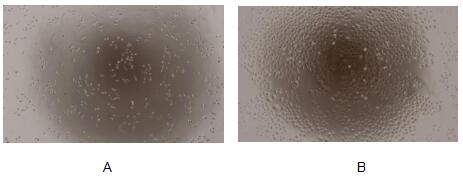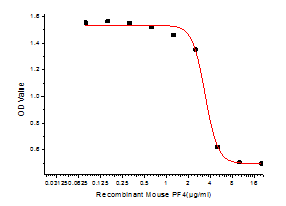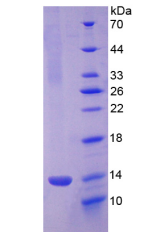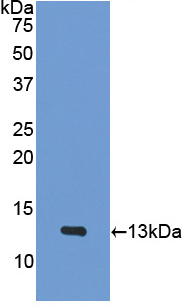Active Platelet Factor 4 (PF4) 

CXCL4; SCYB4; Chemokine C-X-C-Motif Ligand 4; Oncostatin-A; Iroplact
Overview
Properties
- Product No.APA172Mu01
- Organism SpeciesMus musculus (Mouse) Same name, Different species.
- ApplicationsCell culture; Activity Assays.
Research use only - DownloadInstruction Manual
- CategoryCytokineHematology
- Buffer Formulation20mM Tris, 150mM NaCl, pH8.0, containing 1mM EDTA, 1mM DTT, 0.01% SKL, 5% Trehalose and Proclin300.
- Traits Freeze-dried powder, Purity > 90%
- Isoelectric Point9.4
Sign into your account
Share a new citation as an author
Upload your experimental result
Review

Contact us
Please fill in the blank.
Activity test

Platelet factor 4 (PF4) is a small cytokine belonging to the CXC chemokine family that is also known as chemokine (C-X-C motif) ligand 4 (CXCL4). This chemokine is released from alpha-granules of activated platelets during platelet aggregation, and promotes blood coagulation by moderating the effects of heparin-like molecules. Due to these roles, it is predicted to play a role in wound repair and inflammation. To measure its ability to inhibit the FGF basic-dependent proliferation of HUVEC human umbilical vein endothelial cells, HUVEC cells were seeded into 96-well plates at a density of 3,000 cells/well with 2% serum standard DMEM including 1μg/mL recombinant human FGF1 and various concentrations of recombinant human PF4. After incubated for 48h, cells were observed by inverted microscope and cell proliferation was measured by Cell Counting Kit-8 (CCK-8). Briefly, 10µL of CCK-8 solution was added to each well of the plate, then the absorbance at 450nm was measured using a microplate reader after incubating the plate for 1-2 hours at 37℃. Proliferation of HUVEC cells after incubation with PF4 for 48h observed by inverted microscope was shown in Figure 1. Cell viability was assessed by CCK-8 (Cell Counting Kit-8) assay after incubation with recombinant human PF4 for 48h. The result was shown in Figure 2. It was obvious that PF4 significantly FGF basic-dependent proliferation of HUVEC cells. The ED50 is 3.4μg/mL.
(A)HUVEC cells cultured in DMEM with 1μg/mL FGF1, stimulated with 5μg/mL PF4 for 48h;
(B) Unstimulated HUVEC cells cultured in DMEM with 1μg/mL FGF1 for 48h.
Figure. Inhibition of HUVEC cells proliferation after stimulated with PF4.

Figure. Inhibition of FGF basic-dependent HUVEC proliferation after stimulated with PF4.
Usage
Reconstitute in 20mM Tris, 150mM NaCl (PH8.0) to a concentration of 0.1-1.0 mg/mL. Do not vortex.
Storage
Avoid repeated freeze/thaw cycles. Store at 2-8°C for one month. Aliquot and store at -80°C for 12 months.
Stability
The thermal stability is described by the loss rate. The loss rate was determined by accelerated thermal degradation test, that is, incubate the protein at 37°C for 48h, and no obvious degradation and precipitation were observed. The loss rate is less than 5% within the expiration date under appropriate storage condition.
Increment services
-
 BCA Protein Quantification Kit
BCA Protein Quantification Kit
-
 Molecular Mass Marker for Protein
Molecular Mass Marker for Protein
-
 Monoclonal Antibody Customized Service
Monoclonal Antibody Customized Service
-
 Polyclonal Antibody Customized Service
Polyclonal Antibody Customized Service
-
 Protein Activity Test Experiment Service
Protein Activity Test Experiment Service
-
 Electrophoretic Mobility Shift Assay (EMSA) Experiment Service
Electrophoretic Mobility Shift Assay (EMSA) Experiment Service
-
 Buffer
Buffer
-
 Lentivirus Packaging Experiment Service
Lentivirus Packaging Experiment Service
-
 Adenovirus Packaging Experiment Service
Adenovirus Packaging Experiment Service
-
 Real Time PCR Experimental Service
Real Time PCR Experimental Service
-
 Spike RBD Protein (S-RBD)
Spike RBD Protein (S-RBD)
-
 Protein G
Protein G
-
 Protein A
Protein A
Citations
- Propofol lowers serum PF4 level and partially corrects hypercoagulopathy in endotoxemic ratsPubMed: 20601223
- Secretome of apoptotic peripheral blood cells (APOSEC) attenuates microvascular obstruction in a porcine closed chest reperfused acute myocardial infarction model: role of platelet aggregation and vasodilationPubMed: 22899170
- Platelets Recognize Brain-Specific Glycolipid Structures, Respond to Neurovascular Damage and Promote NeuroinflammationPubMed: PMC3608633
- Effect of splenectomy on platelet activation and decompression sickness outcome in a rat model of decompressionPubmed:25311322
- A Phellinus baumii–based supplement containing Salvia miltiorrhiza Bunge improves atherothrombotic profiles through endothelial nitric oxide synthase and cyclooxygenase pathwaysin vitro and in vivoscience:S1756464616300676
- Aspirin, but Not Tirofiban Displays Protective Effects in Endotoxin Induced Lung Injurypubmed:27583400
- Evidence of the Role of R-Spondin 1 and Its Receptor Lgr4 in the Transmission of Mechanical Stimuli to Biological Signals for Bone Formation.pubmed:28272338
- Feasibility of improving platelet‑rich plasma therapy by using chitosan with high platelet activation abilitypubmed:28450960
- Aspirin pre-treatment modulates ozone-induced fetal growth restriction and alterations in uterine blood flow in ratsPubmed: 30528429
- Short and long-term changes in platelet and inflammatory biomarkers after cryoballoon and radiofrequency ablationPubmed: 30857843
- Evaluating the Platelet Activation Related to the Degradation of Biomaterials by Scheme of Molecular Markers
- Newly Identified HNP‐F from Human Neutrophil Peptide 1 Promotes HemostasisPubmed: 30927490
- Data for short and long-term prothrombotic biomarkers after cryoballoon and radiofrequency ablation
- Evaluating Platelet Activation Related to the Degradation of Biomaterials Using Molecular MarkersPubmed: 32812629
- The Inhibitory Effect of Protamine on Platelets is Attenuated by Heparin without Inducing Thrombocytopenia in RodentsPubmed: 31533230
- Feasibility study of use of rabbit blood to evaluate platelet activation by medical devicesPubmed: 31838449
- The C5a/C5a receptor 1 axis controls tissue neovascularization through CXCL4 release from platelets34099640
- The effect of ChAdOx1 nCov-19 vaccine on arterial thrombosis development and platelet aggregation in female ratsPubmed:35183388








